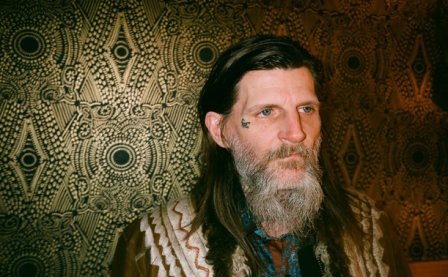After “Father Midnight” and “Hell’s Winter,” the deeper magic and Aslan’s breath — a cough of hope in a fatalist wheeze. There is something dreadful about the beauty of this dawn, the inevitability of its cycle suggesting the daunting physicality of Ted Hughes’ Iron Man on the march, as if dread were, in fact, a condition of the beautiful, whose details can only be examined or demonstrated in the shade of anxiety’s big pink parasol. Fear circumscribes the world, drawing the earth towards it, submitting its sign to the siphon squeeze of the pars totalis. If Earth have taken their furthest steps yet from the cloistered encampment of doom, tapering at the edges of electric folk, it is only in order to discover what they already knew: that dread is the condition of sensitivity wherein the beauty of details is magnified. In this sense, Angels of Darkness, Demons of Light II represents a spilling-forth from the citadel, an eldritch ritual of fire and shadow performed in the shelter of hallucinogenic crags. The Earth machine feeds on form to stabilize its torpor. Its hibernation is a site of constant, slow-motion chewing: a continuum of crushing and grinding, a ruminant dread, a stoner Unicron.
Monsters are crises that demand to be resolved, and the cartoonish Tairona figurines of Stacey Rozich that scuttle and swoon across the two volumes of Angels of Darkness, Demons of Light suggest a crisis of representation decisively resolved in a bold skewering of angles. Giorgio DeChirico’s faceless figures of urban alienation have got lost on the West Highland Way; folk jazz combo The Advancement have gone on tour with Spinal Tap. Ivy-twining fret runs snake into eaves of feedback in a chiaroscuro counterpoint. Power chords jangle with the reverb of a nerve consistently struck and frayed. The drumming, a secret law — a hidden, spectral centrifuge animated and concealed by a tension between a cheeseparing economy of meter and a fiddly, indulgent breadth of timbre (Moe Tucker on her wedding night?), recalling Levinas’ grimly seductive vision of ontic unease, the Il y a: “It is something resembling what one hears when one puts an empty shell close to the ear, as if the emptiness were full, as if the silence were a noise.”
The timeless mastery of the virtuoso craftsmen and their negotiations with history: this is the vocabulary of classic heavy rock, crucially mangled by its means; producing the effect of the weird — what Harold Bloom variously described as “an originality that can achieve canonical status… a strangeness that we never altogether assimilate… such a given that we are blinded to its idiosyncrasies”:
“Some years ago, on a stormy night in New Haven, I sat down to reread, yet once more, John Milton’s Paradise Lost… I wanted to start all over again with the poem: to read it as though I had never read it before, indeed as though no one had ever read it before me… and while I read, until I fell asleep in the middle of the night, the poem’s initial familiarity began to dissolve… although the poem is a biblical epic, in classical form, the peculiar impression it gave me was what I generally ascribe to literary fantasy or science fiction, not to heroic epic. Weirdness was its overwhelming effect.” (Harold Bloom, An Elegy For The Canon)
The ambient materialism of Angels of Darkness, Demons of Light II presents a similarly weird, irregular surface upon which, unevenly pressed, a codex of dark ecstasies and florid circumlocution lies — traceable by touch, cogent in dreams, the fibers of its text bear the weight of a psychedelic meisterwerk. It conjures images of fossils, of precious stones: strange mutations wrought by time, the undeniable force of abstractions made concrete.
More about: Earth




